
I’ve received quite a few questions recently regarding the practice of heart burial in Tudor times, so I thought I’d share these talks on heart burial, and burial in general, from our archives…
[Read More...]
I’ve received quite a few questions recently regarding the practice of heart burial in Tudor times, so I thought I’d share these talks on heart burial, and burial in general, from our archives…
[Read More...]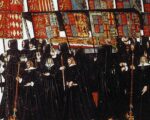
People all over the world have tuned in to watch the funeral of Queen Elizabeth II today, a queen who reigned for over 70 years and who was descended from Margaret Tudor, Queen of Scotland, and, therefore, King Henry VII, as well as having Boleyn blood.
The funeral procession and ceremony were full of tradition and ritual, and our Tudor ancestors would recognise much of it, so I thought I’d share with you some information on Tudor royal funerals.
[Read More...]
On this day in Tudor history, 14th August 1513, in the reign of King Henry VIII, William Parr, Marquess of Northampton and brother of Queen Catherine Parr, was born.
William Parr is a fascinating man. He had a wonderful court career, his first wife eloped and left him, his divorce was granted and then rescinded, he was imprisoned in the Tower but then released, his marital happiness was rather shortlived… but he died a natural death!
[Read More...]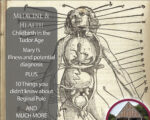
As today is the anniversary of physician and paediatrician Thomas Phaer making his will on 12th August 1560, and he was known for some rather interesting remedies – find out about him here – I thought I’d share the July 2019 edition of Tudor Life magazine which focused on Tudor Medicine and Health…
[Read More...]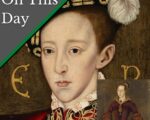
On this day in Tudor history, 6th July 1553, fifteen-year-old King Edward VI died at Greenwich Palace.
His “devise for the succession” named his heir as Lady Jane Grey, the daughter of Edward’s cousin, Frances Grey (née Brandon), Duchess of Suffolk.
[Read More...]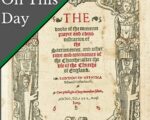
On this day in Tudor history, 6th June 1549, in the reign of King Edward VI, an army of rebels assembled at Bodmin in Cornwall. A town meeting was held, in which the rebels’ demands were put forward.
These men were rebelling against the recent religious changes, particularly the new law concerning the Book of Common Prayer.
Trouble ensued and their grievances became a full-blown rebellion, the Prayer Book Rebellion. You can find out what happened next and how the rebellion ended in this video:
[Read More...]
The Tudors have an enduring appeal across the centuries and as soon as the film era hit, people were busy making movies about our favourite characters and events. This month we have a popular-culture filled magazine with all sorts of articles about how the Tudors have been represented. [Read More...]
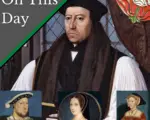
On this day in Tudor history, 19th May 1536, Queen Anne Boleyn was executed within the confines of the Tower of London.
It must have been an incredibly hard day for the queen’s friend, Archbishop Thomas Cranmer. Not only did he have a visit from a friend regarding a terrifying vision, in the early hours… Not only did he have to cope with the idea of his friend and patron being beheaded, but he had to issue a dispensation for the king to marry again!
[Read More...]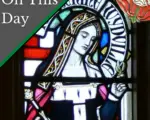
On this day in Tudor history, 18th May 1497, Catherine Woodville, Duchess of Buckingham and Bedford, died.
Who was Catherine Woodville and how was she linked to the famous Woodvilles who rose in the reign of King Edward IV?
[Read More...]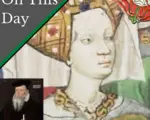
On this day in Tudor history, 3rd May 1415, Cecily Neville, matriarch of the House of York and mother of two kings, was born.
Find out about this Duchess of York, and how she is linked to royalty and the Tudors…
[Read More...]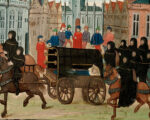
As yesterday was the anniversary of the burial of Queen Elizabeth I in 1603, I thought I’d share these two talks on Tudor burial from the Tudor Society archives.
In this two-part series on burial in Tudor times, I discussed how the remains of a commoner were prepared for burial, then those of the wealthier classes, with real examples from the records, and I also discussed the subjects of embalming, and heart and entrails burial.
[Read More...]
What happens when a jury doesn’t find an alleged traitor guilty and, instead, acquits him? Well, the jurors get arrested and thrown into prison, of course!
I explain exactly what happened on this day in Tudor history, 17th April 1554, in the case of Sir Nicholas Throckmorton. I also give details on how the jurors finally got released and what happened to Throckmorton.
[Read More...]
It’s a busy date in Tudor history today!
On this day in Tudor history, 14th April 1578, Mary, Queen of Scots’ third husband, James Hepburn, Duke of Orkney and 4th Earl of Bothwell, died at Dragsholm Castle in Denmark. He’d been held at the castle in appalling conditions and it was said that he’d gone insane.
Find out more about the life of this earl who’d risen to be the husband of Mary, Queen of Scots, but who’d died in prison, far away from home…
[Read More...]
On this day in Tudor history, 13th April 1557, John Brydges, 1st Baron Chandos of Sudeley, landowner, soldier and Lieutenant of the Tower of London, died at his home, Sudeley Castle in the Cotswolds.
Brydges served Henry VIII, King Edward VI and Mary I loyally, and even managed to keep royal favour with Mary I after being accused of being too lenient with prisoners Lady Jane Grey and Princess Elizabeth (future Elizabeth I).
Let me tell you more about Brydges and his time in charge of Lady Jane Grey and Elizabeth I.

On this day in Tudor history, 21st March 1603, a dying Queen Elizabeth I finally took to her bed.
Elizabeth I had been queen since November 1558, but now she was dying. She had deep-rooted melancholy, couldn’t sleep and was refusing to eat. She spent her days lying on cushions in her withdrawing chamber. But on 21st March, she was finally persuaded to go to bed.
Find out more about these last days in this talk…
[Read More...]
On this day in Tudor history, 17th March 1565, Scottish theologian and Reformer Alexander Alesius (also known as Ales, Aless), died in either Leipzig or Edinburgh.
Alesius wrote a huge number of theological works, was friends with reformers Philip Melancthon and Thomas Cranmer, Archbishop of Canterbury, but had a row with the Bishop of London at one point.
Find out more about Alexander Alesius and his terrifying vision or nightmare he experienced in the early hours of 19th May 1536, the day of Queen Anne Boleyn’s execution in this talk…
[Read More...]
On this day in Tudor history, 23rd December 1558, just over a month after her accession, England’s new queen, Elizabeth I, daughter of King Henry VIII and his second wife, Anne Boleyn, moved from Somerset House to Whitehall Palace, which became her principal residence.
Whitehall, formerly York Place, had once been home to her mother, Anne Boleyn, and had been the setting of Anne’s marriage to Henry VIII. I wonder if Elizabeth felt close to her mother there.
Find out more about Whitehall Palace, and also Somerset Place, the property Elizabeth left, in this talk…
[Read More...]
On this day in Tudor history, 15th December, 1560, Comptroller of the Household to Elizabeth I and Lord Lieutenant of Berkshire, Thomas Parry died. The Spanish ambassador claimed that Parry had died of “sheer grief”. He was buried at Westminster Abbey.
Parry had served Elizabeth since 1547 and was a loyal servant and friend. So why did he die of grief?
Find out more about Thomas Parry, his background, life, and why he was upset in 1560, in this talk…
[Read More...]
On this day in Tudor history, 12th November 1555, Mary I’s Lord Chancellor, Stephen Gardiner, Bishop of Winchester, died. He was laid to rest at Winchester Cathedral in what is now known as the Bishop Gardiner Chantry Chapel.
In this talk, I tell you about the life and career of "Wily Winchester", a man who went from being a valued advisor to being imprisoned, and then got back into favour, crowned a queen and became Lord Chancellor! He led quite a life!

On this day in Tudor history, 3rd November 1534, Parliament passed the First Act of Supremacy, establishing King Henry VIII’s supremacy of the English church and rejecting the authority of the pope.
In today’s talk, historian Claire Ridgway shares what the act said and explains that it didn’t actually make him head of the church, just confirmed the fact, and goes on to share the oath that people had to take and what it meant if they refused.
It was an important act in the break with Rome and the English Reformation.
[Read More...]
On this day in Tudor history, 16th October 1532, while Henry VIII and Anne Boleyn, Marquess of Pembroke, were on their visit to Calais, English nobles met French nobles to arrange a meeting between the King of England and his French counterpart, King Francis I.
In this video, I give details on this event, who was there, what happened, and why Henry VIII and Anne Boleyn had gone to Calais…
[Read More...]
On this day in history, 23rd September 1605, in the reign of King James I, Tudor pamphleteer William Averell was buried at St Peter upon Cornhill.
Averell’s first work was about two Welsh star-crossed lovers, Charles and Julia, and he also wrote a Protestant work about it raining wheat in Suffolk and Essex, an event which he saw as presaging the end of the world.
Averell was an interesting character and you can find out more about him and his work in this video…
[Read More...]
On this day in Tudor history, 19th September 1560, explorer, navigator and privateer Thomas Cavendish was baptised at St Martin’s Church, Trimley St Martin in Suffolk.
Cavendish is known for his imitation of Sir Francis Drake’s circumnavigation of the globe, which he undertook in 1586, and for being the first Englishman to explore the island of St Helena, in the mid-Atlantic, but he also had a reputation as a spendthrift and his final voyage was a failure.
Find out more about Thomas Cavendish…
[Read More...]
On this day in Tudor history, 31st August 1545, a contagious disease known as the ‘Bloody flux’ hit the port of Portsmouth, killing many of the men serving on the ships in its port.
But what was the Bloody Flux? What were its symptoms and why did it kill so many soldiers and sailors?
Find out about the disease, famous victims of the Bloody Flux, and how it is still affecting people today…
[Read More...]
On this day in Tudor history, 30th August 1525, the Treaty of the More was agreed between King Henry VIII of England and Louise of Savoy, who was acting as regent for her son, King Francis I of France, while he was imprisoned by imperial forces.
Why was Francis in prison? What were the terms of the Treaty of the More? How did this treaty affect Henry VIII’s daughter, Mary? And what happened next.
Find out all about the Treaty of the More and its consequences…
[Read More...]
On this day in Tudor history, 14th August 1513, William Parr, Marquess of Northampton and brother of Queen Catherine Parr, was born.
William Parr is a fascinating man. He had a wonderful court career, his first wife eloped and left him, his divorce was granted and then rescinded, he was imprisoned in the Tower but then released, his marital happiness was rather shortlived… but he died a natural death!
Find out more about William Parr…
[Read More...]
On this day in Tudor history, 8th August 1503, King Henry VII’s eldest daughter, Margaret Tudor, married King James IV of Scotland.
Find out more about their marriage, and how it was arranged, in this edition of #TudorHistoryShorts…
[Read More...]
On this day in Tudor history, 3rd August 1549, in the reign of King Edward VI, Lord Russell marched his troops from Honiton to Woodbury.
They were off to put down the Prayer Book Rebellion.
Find out more in this edition of #TudorHistoryShorts…
[Read More...]
On this day in Tudor history, 31st July 1549, Edmund Sheffield, 1st Baron Sheffield, was killed by a butcher during Kett’s Rebellion in East Anglia.
What happened?
Find out…
[Read More...]
On this day in history, 25th July 1602, in the reign of King James I, thirteen-year-old Elizabethan actor Salomon Pavy was buried at the Church of St Mary Somerset, near Blackfriars Theatre.
Find out more about Salomon Pavy and how he came to be an actor in this edition of #TudorHistoryShorts…
[Read More...]